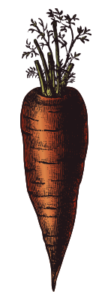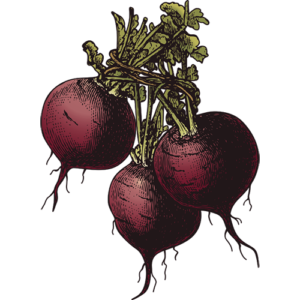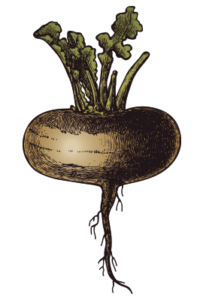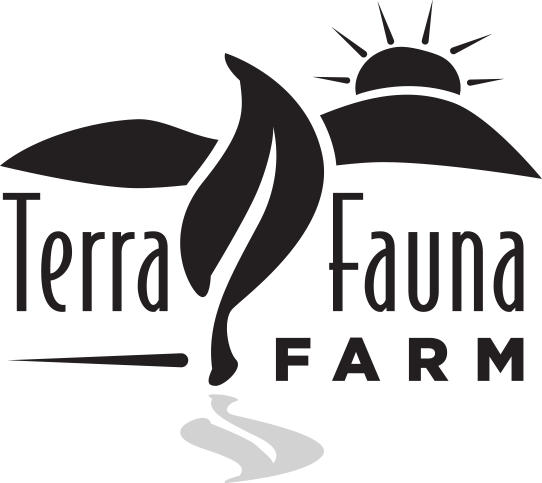Root Vegetables
ASPARAGUS
DESCRIPTION (Purple Passion):
This variety is described as mild, sweet and nutty. Asparagus is high in Vitamin K, flavenoids, fiber, low in sodium and low in calories. The purple stalks turn green when cooked.
DESCRIPTION (Jersey Knight):
This large and tender variety is prolific and delicious. Like any other asparagus, it is high in Vitamin K and fiber, but low in calories and sodium.
STORAGE:
Store upright in a container, with the cut part of the stems standing in about an inch of water. Change the water every two days. Store in the coldest part of your refrigerator.
BEST USED:
Roasted, steamed, raw, stir-fried, grilled.
ACCOMPANYING FLAVORS:
Butter, olive oil, hollandaise sauce, Parmesan cheese, mayonnaise.
RECIPES:
Here’s a yummy, simple side dish!
Wow anyone with this prosciutto wrapped asparagus!
 CARROTS
CARROTS
DESCRIPTION (Scarlet Nantes):
These sweet carrots are nearly coreless, bright, and brittle. Carrots are a great source of vitamin A and beta-carotene.
DESCRIPTION (Mokum):
These orange carrots are sweet and slender. See above for nutritional information.
DESCRIPTION (Sugar Snax):
These super sweet carrots are bright orange indicating their extra high beta-carotene content.
STORAGE:
Remove the greens. Store in an airtight container in the coolest part of your refrigerator. Wash right before use.
BEST USED:
Raw, boiled, steamed, roasted, fried, in soups or stews.
ACCOMPANYING FLAVORS:
Salt, brown sugar, butter, shallots, parsnips, olive oil, pepper, honey, dressings.
RECIPES:
Check out these awesome roasted carrots!
These honey glazed carrots will put a smile on anyone’s face.
Carrot souffle is a great side dish or meal for brunch.
KOHLRABI
DESCRIPTION (Winner):
This interesting looking vegetable is a relative of cabbage. Its root has a sweet, mild flavor, similar to cabbage heart or broccoli stem. Both the greens (similar to kale or collards) and root are edible.
STORAGE:
Refrigerate in a plastic bag. It should keep about four or five days. It can also be frozen for months!
BEST USED:
Raw, in slaws or salads, steamed, boiled, baked, grilled, roasted.
ACCOMPANYING FLAVORS:
Beets, kale, apples, cauliflower, carrots, butter, garlic, cream sauce, nutmeg.
RECIPES:
This kohlrabi noodle and arugla salad must be tried!
POTATOES
DESCRIPTION (Fingerlings):
These potatoes are short and stubby, normally with tan skin and white flesh. Potatoes are starchy, high in vitamins B6 and C.
DESCRIPTION (Early):
This variety is small with a white, waxy flesh. They are very tasty! See above for nutritional info.
DESCRIPTION (Russet):
These large potatoes have dark brown skin and white, dry, mealy flesh. It is often used for mashing, baking and frying. See above for nutrition facts.
STORAGE:
Potatoes cannot be stored anywhere cold, for low temperatures promote the breakdown of starch. Instead, store in a cool, well ventilated space such as a basement or closet.
BEST USED:
Roasted, baked, fried, mashed, stewed.
ACCOMPANYING FLAVORS:
Butter, cheddar cheese, cream, onions, bacon, garlic, rosemary, leeks.
RECIPES:
These crispy fingerlings sound amazing!
Roasted new potatoes? Count me in.
Forever drooling over these au gratin potatoes.
RADISH
DESCRIPTION (Cherry Belle):
These radishes are scarlet, round and smooth with a sharp, white flesh. They are a good source of vitamin C.
DESCRIPTION (French Breakfast):
This gourmet variety has a red top and white bottom. It has a spicy flavor. See above for nutrition info!
STORAGE:
Store in a plastic bag in your refrigerator after removing the leaves. They should keep for about a week.
BEST USED:
Raw, in salads.
ACCOMPANYING FLAVORS:
Butter, cilantro, leeks, creamy cheeses, bacon, crab.
RECIPES:
Grilling radishes is a great way to eat them!
You’ll definitely dig this dip.
BEETS
DESCRIPTION (Red Ace):
This red, tender and smooth variety has vibrant scarlet rings. They are a good source of folate and manganese. Beet roots are the most commonly eaten part of the vegetable, but the greens may also be eaten.
DESCRIPTION (Root Grex):
This mix contains yellow, purple and red varieties. They are hardy and delicious! As stated above, beets are nutritious and can be utilized both for their root and leaves.
DESCRIPTION (Touchstone Gold):
These lovely golden beets have beautiful green tops. They retain their color when cooked and have a sweet flavor favored by foodies. The greens may be eaten and the vegetable is s great source of folate and manganese.
STORAGE:
Trim the leaves two inches from the root, but do not trim the tail. The leaves may be stored for up to two days in a separate airtight bag. The roots may be stored in an airtight bag in the crisper section of your refrigerator for up to ten days. Beets may also be frozen up to ten months!
BEST USED:
Boiled, baked, steamed, fried, grilled, pickled.
ACCOMPANYING FLAVORS:
Goat cheese, lettuce, rosemary, olive oil.
RECIPES:
Ever think of making beet pasta? Well, now you have… and here is how.
Borscht is a Russian classic!
Yummy! Try these beet, goat cheese, and honey tarts.
CELERIAC
DESCRIPTION (Brilliant):
Sometimes called celery root, this vegetable is knobby and bulbous. It has a taste similar to celery and parsley. It is a good source of vitamin K.
STORAGE:
Store unwrapped at the bottom of your refrigerator, or somewhere cool and damp. It should keep for several weeks. Even if cut, it should keep for about a week (but shave off a layer to refresh the surface.)
BEST USED:
Roasted, stewed, blanched, raw (in salads) or mashed.
ACCOMPANYING FLAVORS:
Potatoes, carrots, beets, apples, rosemary, thyme, garlic.
RECIPES:
Check out this celeriac, potato, and rosemary gratin.
PARSNIPS
DESCRIPTION (Andover):
Related to carrots and parsley, this root vegetable tastes like a carrot-potato hybrid. It has a sweet taste when cooked. They are high in manganese, Vitamin C and Vitamin K.
STORAGE:
Keep in a cool, humid space (such as a cellar or refrigerator drawer) in a plastic bag to retain moisture.
BEST USED:
Raw, in stews, baked, boiled, pureed, roasted, fried, steamed.
ACCOMPANYING FLAVORS:
Butter, milk, parmesan, olive oil, rosemary, coriander, cumin.
RECIPES:
Wow! Try risotto with parsnips and greens.
RUTABAGA
DESCRIPTION (Laurentian):
This vegetable is a cross between a cabbage and a turnip.It is described as tasting like a carrot without the sweetness. It is high in vitamin C.
STORAGE:
Trim the foliage about an inch from the crown. Clean the roots without wetting them, and store in the refrigerator.
BEST USED:
Roasted, baked, boiled, mashed, julienned, in soups. Across the pond, rutabagas are carved into creepy faces to ward off evil spirits.
ACCOMPANYING FLAVORS:
Potato, carrot, onion, butter, pepper.
RECIPES:
These pasties look delectable!
 TURNIPS
TURNIPS
DESCRIPTION (Hakurei):
This smooth, white variety is a sweet, crisp and tender root. It is popular among food critics! Turnips are high in vitamins A, C and K, as well as potassium when uncooked. The greens may also be eaten.
STORAGE:
Remove the leaves and bag separately if you plan on using them. Store greens in the refrigerator for up to a few days. The roots may be stored in a plastic bag, unwashed, in the drawer of your refrigerator or in a cool cellar for up to two weeks. Remove the hairy stem before cooking.
BEST USED:
Boiled, microwaved, steamed, roasted, stir-fried, in slaws. The greens may be used similarly as spinach.
ACCOMPANYING FLAVORS:
Olive oil, bacon, apples, beans, onion, cinnamon, cumin.
RECIPES:
Try glazing your turnips!
